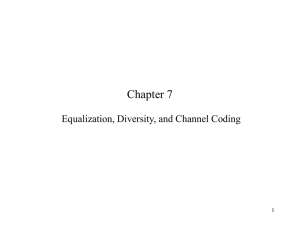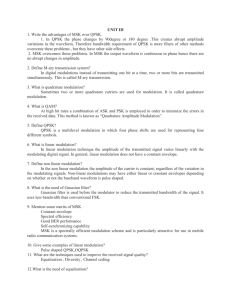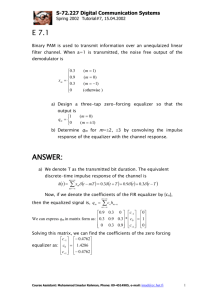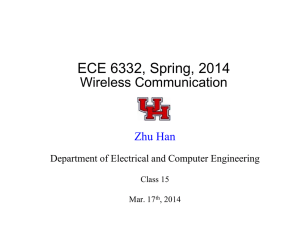jaya-WC-UNIT-IV
advertisement
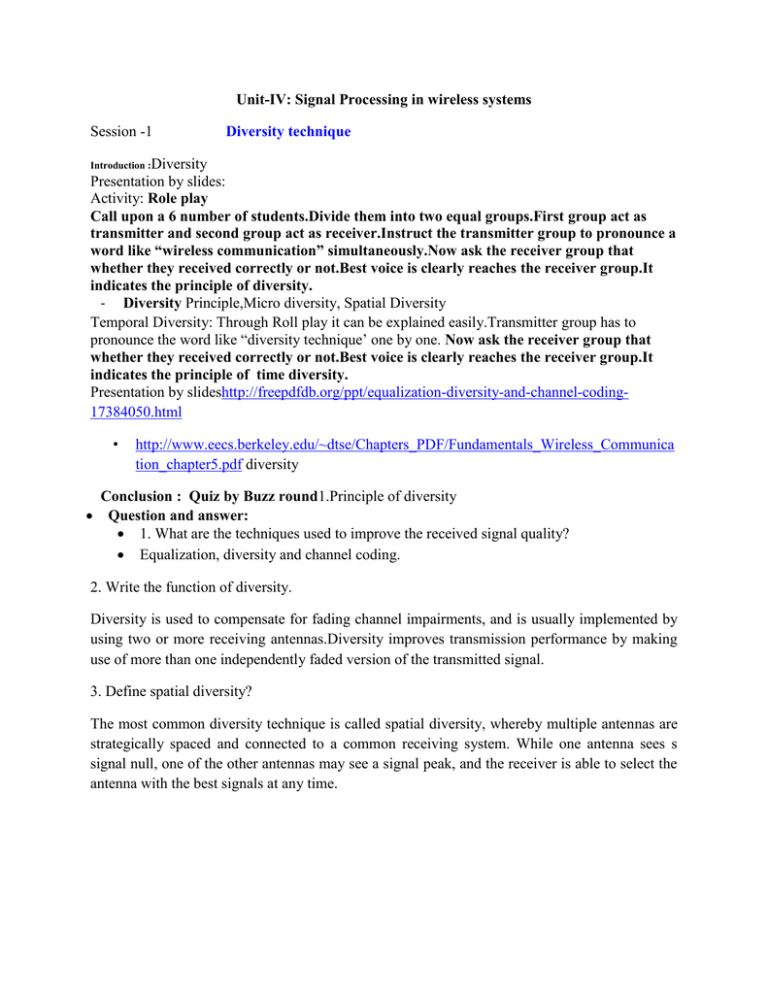
Unit-IV: Signal Processing in wireless systems Session -1 Diversity technique Introduction :Diversity Presentation by slides: Activity: Role play Call upon a 6 number of students.Divide them into two equal groups.First group act as transmitter and second group act as receiver.Instruct the transmitter group to pronounce a word like “wireless communication” simultaneously.Now ask the receiver group that whether they received correctly or not.Best voice is clearly reaches the receiver group.It indicates the principle of diversity. - Diversity Principle,Micro diversity, Spatial Diversity Temporal Diversity: Through Roll play it can be explained easily.Transmitter group has to pronounce the word like “diversity technique’ one by one. Now ask the receiver group that whether they received correctly or not.Best voice is clearly reaches the receiver group.It indicates the principle of time diversity. Presentation by slideshttp://freepdfdb.org/ppt/equalization-diversity-and-channel-coding17384050.html • http://www.eecs.berkeley.edu/~dtse/Chapters_PDF/Fundamentals_Wireless_Communica tion_chapter5.pdf diversity Conclusion : Quiz by Buzz round1.Principle of diversity Question and answer: 1. What are the techniques used to improve the received signal quality? Equalization, diversity and channel coding. 2. Write the function of diversity. Diversity is used to compensate for fading channel impairments, and is usually implemented by using two or more receiving antennas.Diversity improves transmission performance by making use of more than one independently faded version of the transmitted signal. 3. Define spatial diversity? The most common diversity technique is called spatial diversity, whereby multiple antennas are strategically spaced and connected to a common receiving system. While one antenna sees s signal null, one of the other antennas may see a signal peak, and the receiver is able to select the antenna with the best signals at any time. Session -2 Recap: :Diversity Presentation by slides: Frequency Diversity,Angle Diversity and Polarization Diversity • http://djw.cs.washington.edu/papers/mimo_for_dummies.pdf journal • http://www.ll.mit.edu/publications/journal/pdf/vol15_no1/15_1mimo.pdf book • Activity: Role play Call upon a 6 number of students.Divide them into two equal groups.First group act as transmitter and second group act as receiver.Instruct the transmitter group to pronounce a word with different pitch level like “Digital communication” simultaneously.Now ask the receiver group that whether they received correctly or not.Best voice is clearly reaches the receiver group.It indicates the principle of frequency diversity. Conclusion: Recall by keywords 1.Principle of frequency diversity 2.Concept of angle diversity 3define polarization diversity. 4.Applications of each diversity. Session-3 Macro diversity ,Signal combining techniques Activity: Switched Diversity, Combining Diversity “See and Identify” Presentation slides Through block diagram differentiation identify the technique. • http://www.eecs.berkeley.edu/~dtse/Chapters_PDF/Fundamentals_Wireless_Communica tion_chapter5.pdfdiversity G. L. Stuber, Principles of Mobile Communications, 2nd Ed. Kluwer Academic Publishers , 2001. wides.usc.edu/teaching/textbook Conclusion: Learner led presentation Divide the students into 4 groups.Instruct them to prepare questions and answer about Macrodiversity ,Signal combining techniques. Let them interact with each group. Session -4 Transmit Diversity Introduction :Transmit diversity presentation by slides • http://freepdfdb.org/ppt/equalization-diversity-and-channel-coding-17384050.html Conclusion: Recall by keyword Transmitter Diversity - Transmitter Diversity with Channel State Information - Transmitter Diversity with0ut Channel State Information Session -5 Linear Equalizers Introduction: Equalizers Presentation by slides: Linear Equalizers ftp://ftp.esat.kuleuven.ac.be/sista/moonen/reports/lecture5.ppt equalizer http://wireless.ece.ufl.edu/twong/Notes/Comm/ch4.pdf ISI ftp://idc18.seu.edu.cn/Pub2/EBooks/Books_from_EngnetBase/pdf/2167/05.pdfPRoakis book for equaliser www.wiley.com/go/molisch Zero-Forcing Equalizer Conclusion by Rapid fire 1. What is the need of equalization? Equalization can be used to compensate the inter symbol interference (ISI) created by multipath within time dispersion channel. 2. What is equalizer? The device which equalizes the dispersive effect of a channel is referred to as anequalizer. 3. Define adaptive equalizer. To combat ISI, the equalizer coefficient should change according to the channelstatus so as to track the channel variations. Such an equalizer is called an adaptive equalizer since it adapts to the channel variations. 4. Write the major classifications of equalizers Linear equalizers: If the output d(t) is not used in the feedback path to adapt the equalizer. This type of equalizers is called linear equalizer. Non-linear equalizers: If the output d(t) is feedback to change the subsequentoutputs of the equalizer. 5. Write the advantages of lattice equalizer. (i) It is simplest and easily available. (ii) Numerical stability. (iii) Faster convergence. (iv) When the channel becomes more time dispersive, the length of theequalizer can be increased by the algorithm without stopping the operation. (v) Unique structure of the lattice filter allows the dynamic assignment. Recap by key words Presentation by slides www2.egr.uh.edu/~zhan2/ECE4371/ECE4371_class14.ppt zero forcing equalizer https://www.cresis.ku.edu/~rvc/documents/862/862_eqproject.pdf MMSE equalizer http://www.ece.gatech.edu/research/labs/sarl/tutorials/ECE4606/27-Equalization.pdf equalizer ppt Conclusion: questions and answer 1. Write the expression for MMSE of DFE. The minimum mean square error of DFE is given by 2 A DFE has significantly smaller minimum MSE than an LTE. 2. What are the factors used in adaptive algorithms? (i) Rate of convergence (ii) Misadjustment (iii) Computational complexity (iv) Numerical properties Session -6 Decision Feedback Equalizers Recall by keywords Linear Non-linear MMSE Zero forcing Presentation by slides http://pdf.aminer.org/000/275/666/adaptive_transversal_filters_for_multipath_comp ensation_in_microwave_digital_radio.pdf adaptive equalizer http://www.wahyul.community.undip.ac.id/files/2010/07/ADAPTIVEEQUALIZERS.pdf adaptive journal Conclusion by Questions and answers: 1. Write the basic algorithms used for adaptive equalizations. (i) Zero forcing (ZF) algorithm. (ii) Least mean squares (LMS) algorithm. (iii) Recursive least square(RLS) algorithm. 2. Write the advantages of LMS algorithm. (i) The LMS equalizer maximizes the signal to distortion at its output within the constraints of the equalizer filter length. (ii) Low computational complexity and (iii) Simple program. 3. What are the factors used in adaptive algorithms? (i) Rate of convergence (ii) Misadjustment (iii) Computational complexity Numerical properties (iv) 4. What are the non-linear equalization methods are used? Three very effective non-linear methods are used in most 2G and 3G systems. (i) Decision feedback estimation(MLSE) equalization(DFE) (ii) Maximum likelihood sequence (iii) Maximum likelihood symbol detection. 5. Define adaptive equalizer. To combat ISI, the equalizer coefficient should change according to the channel status so as to track the channel variations. Such an equalizer is called an adaptive equalizer since it adapts to the channel variations. Session -7 Channel coding Recap: Source Coding methods Activity:Asking questions 1. What is source coding? 2. List the various types of source coding. 3. Salient features of source coding Presentation : Block code and convolutional code Board activity Presentation: www.wiley.com/go/molisch http://www.slideshare.net/mansri123/linear-block-code http://www.strongsec.com/zhw/EEC_4.pdf ce.sharif.edu/.../Chapter%208%20-%20Code%20Generation.ppt Conclusion :Rapid fire .Define block codes Define convolutional codes Hamming distance Minimum distance Euclidean distance Cyclic codes Session -8 Channel coding Recap by key words block codes convolutional codes Hamming distance Minimum distance Euclidean distance Cyclic codes Presentation by slides:Turbo codes , LDPC codes and TCM codes http://shannon.cm.nctu.edu.tw/comtheory/chap10-1to10-7.pdfall CODES www.csee.wvu.edu/~mvalenti/documents/TurboLDPCTutorial.ppt TURBO orion.math.iastate.edu/linglong/Math690F04/HammingCodes.ppt HAMMING cmrr-star.ucsd.edu/psiegel/pubs/07/ldpc_tutorial.pptLDPC www.comlab.hut.fi/studies/3320/3320%20cyclic%20codes.ppt CYCLIC CODE http://shannon.cm.nctu.edu.tw/comtheory/chap10-1to10-7.pdf ERROR CORRECT CODE Conclusion: Recall by keywords Turbo codes TCM LDPC codes Session -9 speech coding Introduction : Speech coders Presentation by slides: http://www.scribd.com/doc/77544748/LPC http://www.mirlabs.org/nagpur/paper16.pdf journal http://eeweb.poly.edu/~yao/EE3414/speech_coding.pdf http://www.lsv.uni-saarland.de/Vorlesung/Digital_Signal_Processing/Summer06/dsp06_chap12.pdf Conclusion:Recall by keywords 1. Define Encoder. The analog-to-digital converter, located on the transmitter, is also known as theencoder or simply coder. 2. What is Decoder? The digital-to-analog converter, located in the receiver is known as the decoder. 3. Define CODEC. The word CODEC is derived from coder/decoder.Coder (or) encoder = analog-to-digital converter.Decoder = digital –to-analog converter Simply it is the combination of coder and decoder. 4. What are the major classifications of speech coders? a) Waveform coders b) Vocoders(Voice Coder) 5. Define waveform coders. Waveform coders essentially used to reproduce the time waveform of the speech signal as closely as possible. They are designed to be source independent and can hence code equally well a variety of signal. 6. Define vocoders. Vocoders is a circuit used for digitizing voice at a low data rate by using knowledge of the way in which voice sounds are produced. A vocoder is an example of lossy compression applied to human speech. 7. What are the types of speech signals available? a) Voiced b) Unvoiced.Voiced sound: (“m”,”n”,”v” pronunciations) are a result of quasiperiodic vibrations of The vocal chord. Unvoiced: (“f”,”s”,”sh” pronunciations) are fricatives produced by turbulent air flow through a constriction. 8. Write the vocoders parameters. The parameters associated with vocoders are the voice pitch, the pole frequencies of the modulating filter, and the corresponding amplitude parameters. 9. Give the advantages of vocoders. a) It achieves very high economy in transmission bit rate. b) Less robust. 10. What are the types of vocoders available? a) Linear predictive coder (LPC) b) Channel vocoders c) Formant vocoders d) Cepstrumvocoders and e) Voice-excided vocoders. 11. What is LPC vocoder? Linear predictive coders (LPCs) are belongs to the time domain class of vocoders.Thisvocoders attempt to extract the significant features of speech from the time wave form,this is a low bit rate vocoders. 12. Write the applications of CELP. (i) Advanced DSP and VLSI technology, real-time implementation of CELP codec’s are possible. (ii) The CDMA digital cellular standard (IS-95) proposed by QUALCOMM uses a variable rate CELP codec at 1.2 to 14.4 kbps. 13. Mention the advantages of CELP? (i) CELP can provide high quality even when the excitation is coded at only 0.25 bits per sample. (ii) These coders can achieve transmission bit rates as low as 4.8kbps. 14. What are the factors, we are considering to select speech codec’s for mobile communications? Factors must be considered are (a) Compression (b) Overall system cost (c) Capacity (d) End-to-end delay (e) The algorithmic complexity of the coder (f) The dc power requirements (g) Compatibility with existing standards and (h) Robustness of the encoded speech to transmission errors.


